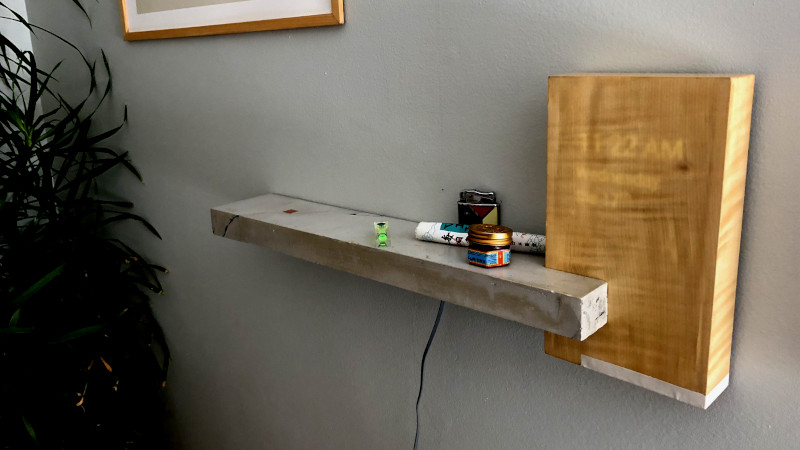Today, it can feel like you’re always connected to the grid. We’re constantly alerted to notifications from smart phones, smart watches, and our houses have begun to swell with all manner of internet-enabled devices. [Jake P] wanted a less connected lifestyle, and built a shelf to help realise that goal.
The idea of [Jake]’s Analog Smart Shelf is to serve as a digital check point in his home. It’s a name that more reflects the ethos of the shelf rather than the components. The shelf contains a Qi wireless charging platform, so smartphones can be placed on the shelf when entering the house and left to charge. The shelf also conceals an Amazon Fire tablet behind woodgrain veneer, which displays the time, weather, and basic notification data. This enables [Jake] to see relevant digital information at a glance, while being able to switch off from the online world by simply walking away.
It’s a well-executed project, which artfully blends wood, concrete, and epoxy to create an attractive final product. It also bears some similarities to smart mirror projects we’ve seen before. It’s a piece we’d be proud to see on our walls, and a great concept for managing one’s digital life, too.



















“while being able to switch off from the online world by simply walking away.”
I hear the gummint is working on a new project for just that. It’s codename is “Outside”.
So he put a phone charger and a laptop, objects which are already in boxes, in boxes?
How is this thing, containing a superfluous extra always-on tablet and keeping your mobile gizmos charged… how is it supposed to contribute to a “less” connected life style again?!
Exactly, this is all over the shop
Um, I guess it makes all those gizmos much like the corded phone used to be… back on the hallway stand. You use it when you want to otherwise it no longer beeps, buzzes etc to distract you. And because it is the modern times … if you are expecting some news you can just check in to see any messages as was the case in the days of answering machines… in the hallway. And, the devices get charged up as well.
Yeah, mildly cool project for those wanting to switch off a bit.
Well, if you have a phone in your pocket, and you want to know what time it is, you might pull out the phone. you might unlock the phone, and start poking at it. it might suddenly become 5 minutes later.
Sometimes diet pills work for people just solely on the fact that they paid money for them, so they’ll follow a diet for as long as the sunk cost fallacy holds out.
“t’s a well-executed project, which artfully blends wood, concrete, and epoxy to create an attractive final product. It also bears some similarities to smart mirror projects we’ve seen before. It’s a piece we’d be proud to see on our walls, and a great concept for managing one’s digital life, too.”
Then someone included the wrong picture, because that is one of the most ugly looking shelf and “box” I have ever seen.
It makes sense to me.
I’ve been thinking of something similar.
What a huge waste of a tablet device. Same effect could be achieved with a simple LCD and pi zero.
He does mention doing more with it at a later stage utilizing the touch functionality.
Eh, depends on what you’re trying to optimize. If its price, a fire tablet 7 costs 40$ on (fairly regular) sale and comes with its own power supply. Compared to a Pi zero W (10$), a power supply for it (5$), SD card (5$), and an “LCD bonnet” (20$), you’re not saving any money. Plus you’re ending up with a much crappier LCD unless you’re dropping more money on the LCD than the whole tablet would be. But you’re losing out on a microphone and full Alexa integration out of the box, you’re trading android for linux and ensuring yourself extra setup time.
I can’t see a single reason to have done this with a raspi & LCD unless those components were free (which just means purchased previously and currently unused)
sounds like the perfect final resting place for my ole hp tablet
… built a shelf to help realise that goal. …
shelf help